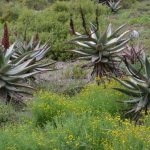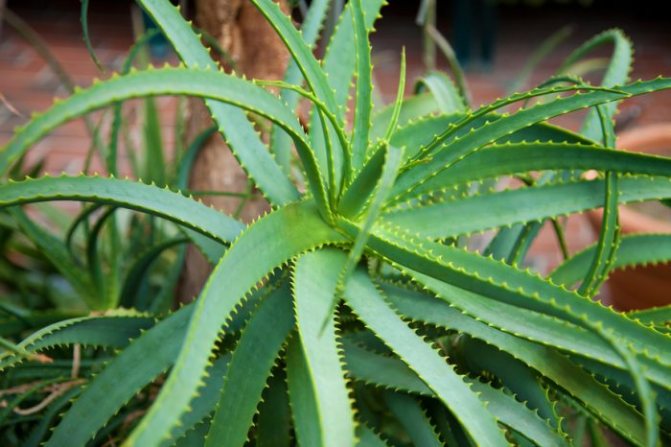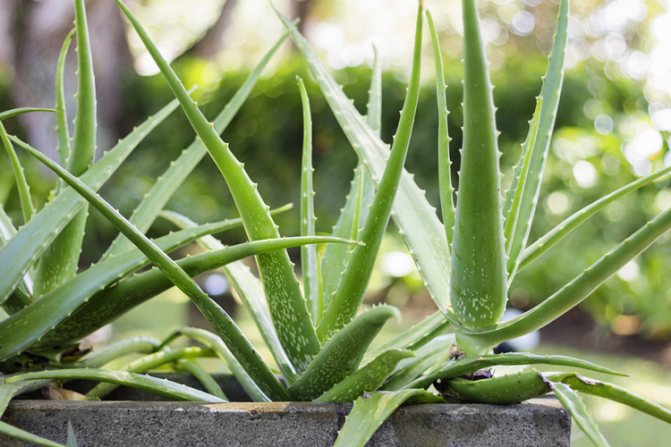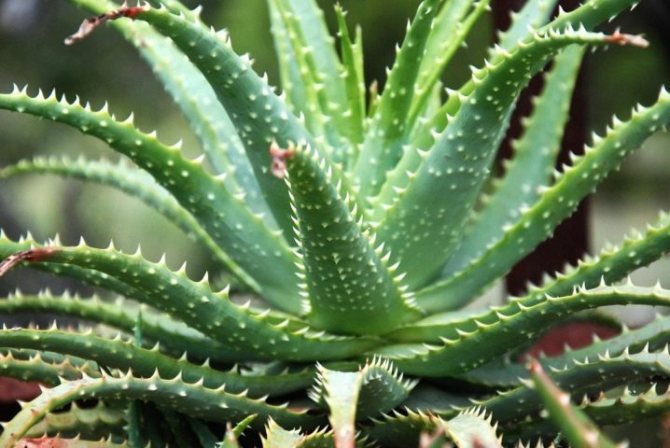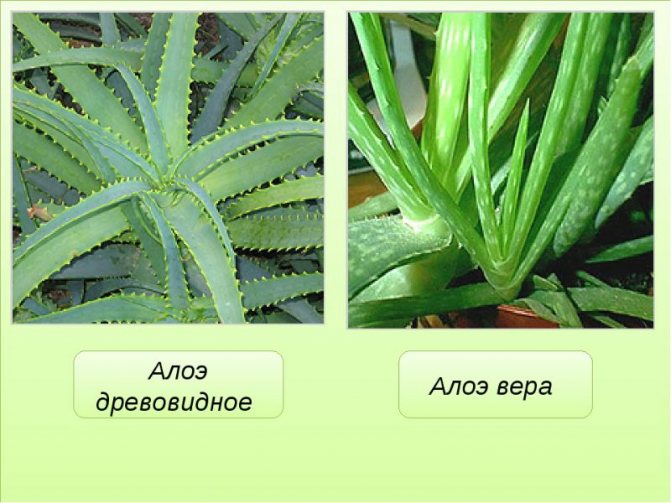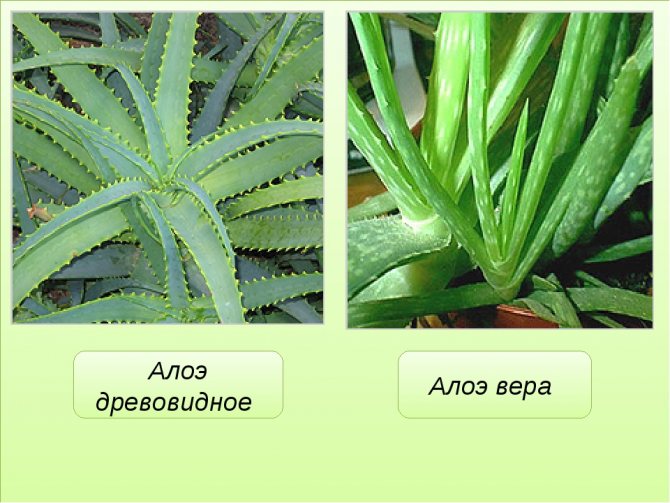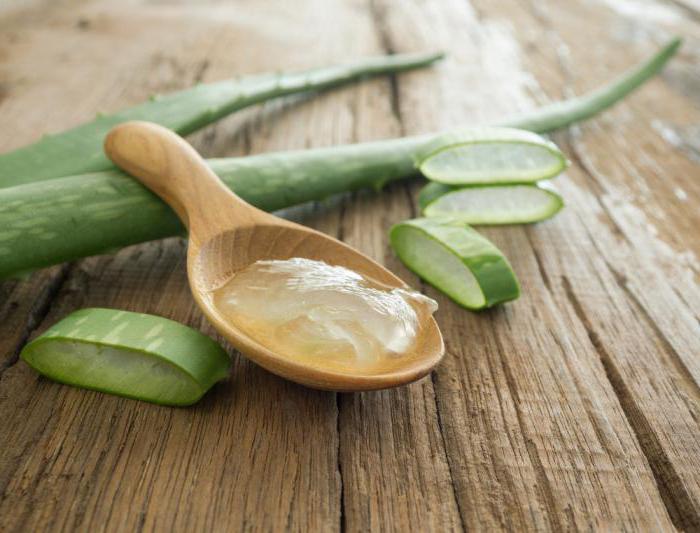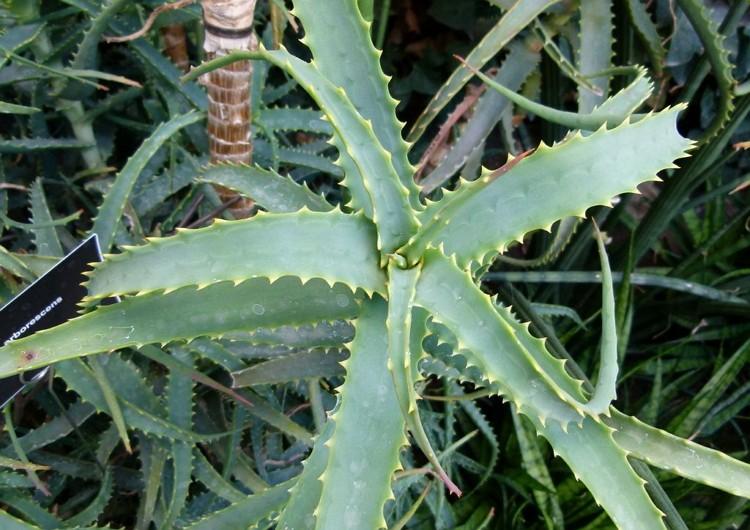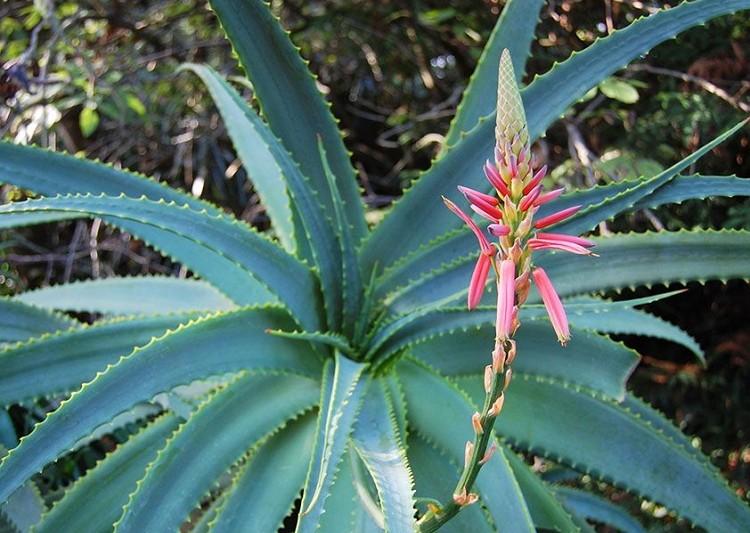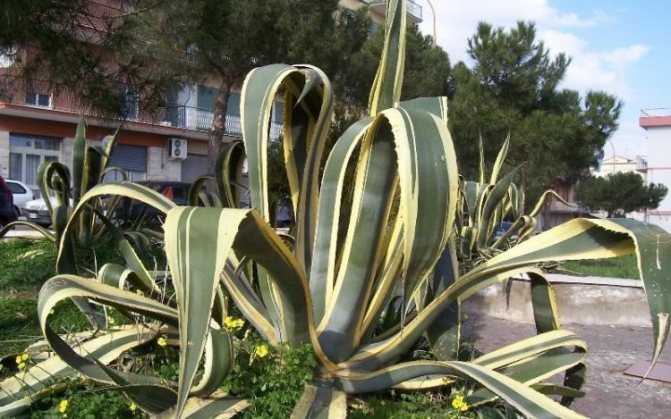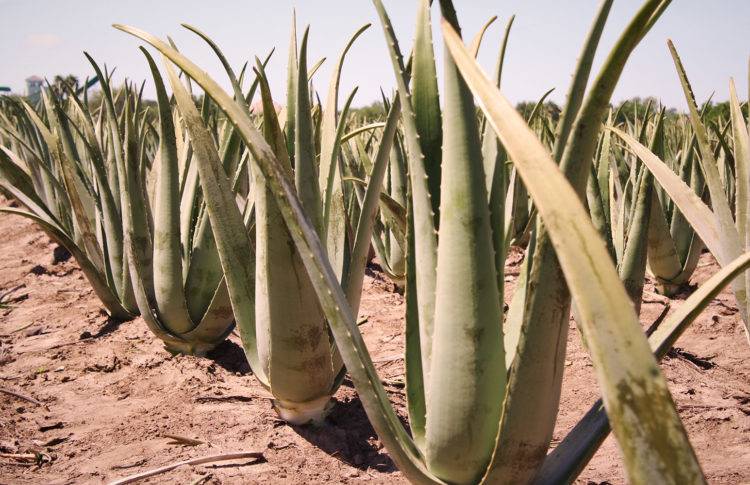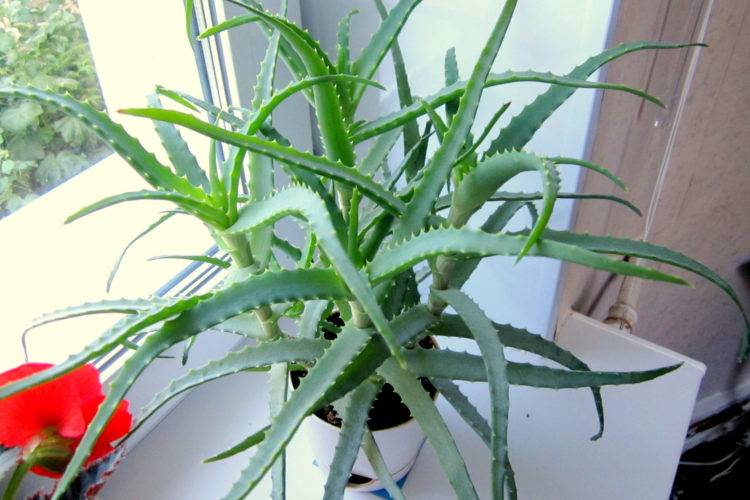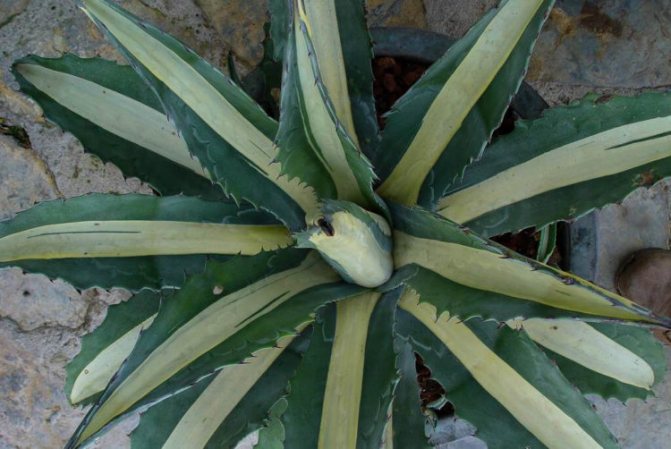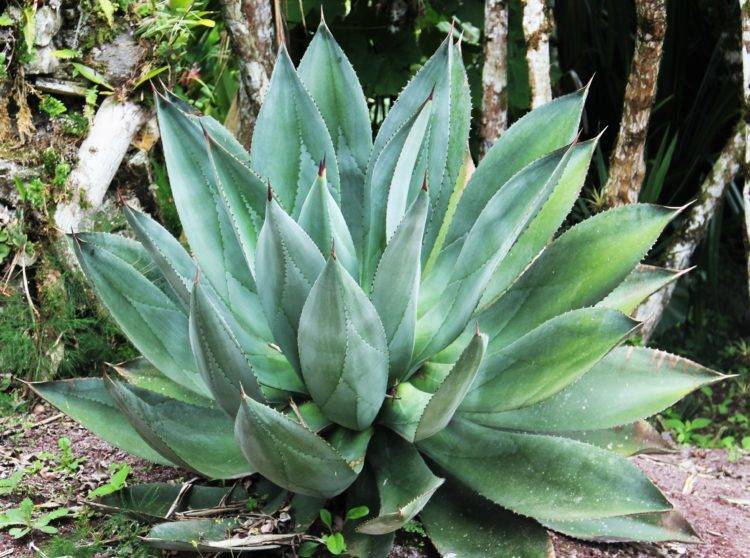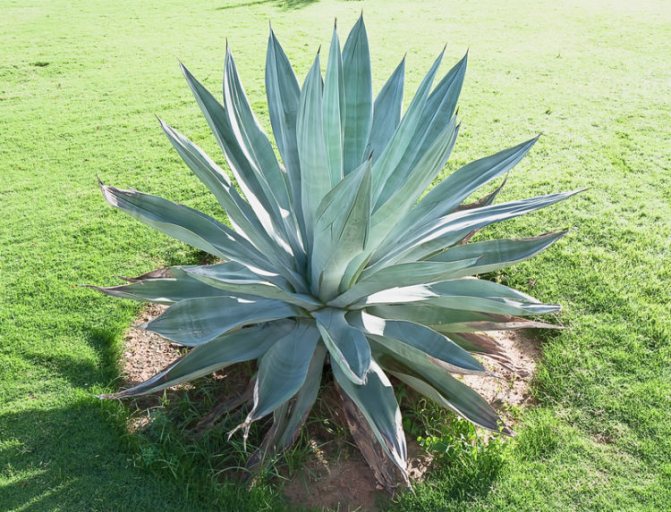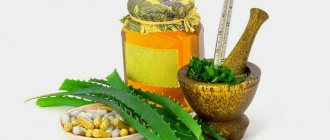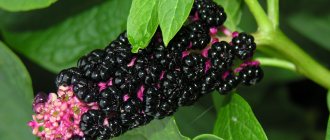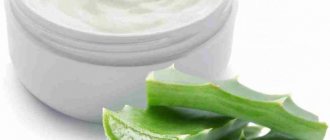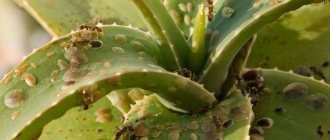How to understand the succulent family in order to learn how to choose edible and healing plants? Medicinal aloe vera has several distinguishing features - focusing on them, you can not get into a mess. How to do it right
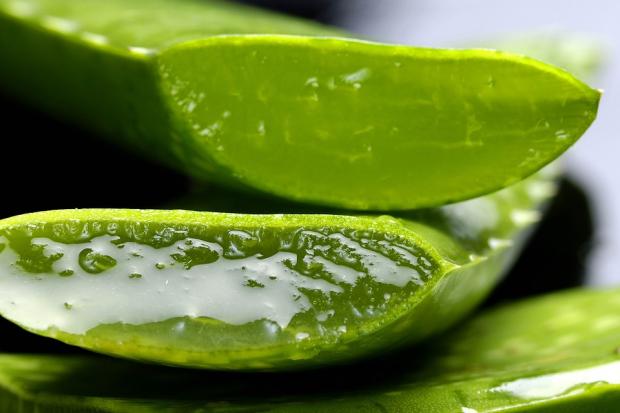
What is it and what family does it belong to?
Aloe tree or agave is a perennial evergreen plant of the genus Aloe. Latin name: Aloe arborescens Mill. There is no unambiguous information about the family to which the aloe tree belongs. Most sources indicate the Liliaceae family. In others - Xanthorrhoeaceae. Recently, the agave belongs to the Asphodelaceae family.
The plant is a succulent. It has a highly branched, fibrous root system. The stem is erect, branching, covered with rings of dead leaves. Reaches four meters in height. The leaves are smooth, juicy, dull, greenish-gray, with a waxy bloom. Sedentary, arranged alternately. In shape, they are xiphoid, linear-lanceolate. They can be up to 30 centimeters long. They have spines bent upward at the edges. There is a mucous core inside the leaf plates.
Flowers are tubular, bell-shaped, pale orange in color. Collected in a racemose inflorescence on a long peduncle. The fruit is a triangular capsule.
Under natural conditions, the aloe tree is found in the semi-desert regions of Africa. In Russia, it is grown mainly as an indoor and greenhouse plant, in the Caucasus - often in the open field.
How to determine the age of an aloe? It is possible to unequivocally determine the age of the agave only if the flower is planted personally. You can be guided by the number of leaves per year - from two to six pieces. The height of a three-year-old aloe tree should be at least 18 - 20 centimeters.
Discovery history and habitat geography
Both species have been known since time immemorial. Aloe vera has a long and well-documented history of use.
There is a hypothesis that it is Aloe vera that is depicted on the walls of an ancient Egyptian temple about 6,000 years old. It is also known that Arab traders delivered expensive powder from the leaves of Aloe vera, the "lily of the desert" as they called it, to India. The famous ancient Greek physician Hippocrates highly appreciated the plant.
Aloe vera is native to the Arabian Peninsula, but is now found in the wild in all temperate and tropical regions, including Australia, China, Mexico, the southern states of the United States and even southern Spain.
The aloe tree was also known to the ancient Egyptians, and they used its juice to mummify the bodies of the dead. Originally from South Africa, it is found naturally in Mozambique, Swaziland, Zimbabwe and Malawi. Like his brother, the agave is widely cultivated in many warm countries.
Types of aloe with photos and names
The most common species - oilseed sunflower and tuberous sunflower, belong to the Aster family.
The sunflower got its name from the merger of two Greek words ‘helios’, which means the sun and ‘anthos’ ‘flower. The sunflower got its "sunny" name due to its pronounced heliotropism (turning of the inflorescence after the sun).Not the last role was played by bright yellow inflorescences, which are strongly associated with the heavenly body.
Sunflower
The generic name for aloe goes back to the Greek ἀλόη, which is derived from Arabic (ألوة / alva) or Hebrew (אהל / ahal, often mentioned in the text of the Bible [4] [5]). The word is borrowed from Greek into Latin in the form aloë.
A more accurate spelling of the scientific name is Aloë, where the letter ë is not the Russian "ё", but the Latin e with a dieresis sign, meaning that in this case the combination oe is pronounced as two separate sounds ("oe").
The word “agave” is used as a common Russian name for some species of the genus Aloe [6].
Differences
Many people confuse aloe vera and agave, believing that they are the same plant. But there are differences, albeit minor ones. The most obvious distinguishing feature of each variety is its appearance. The first plant has long, pointed, thick leaves that grow upward from the root. The centenary grows in the form of a tree with a trunk, from which fleshy leaves with sharp ends diverge.
The shape and size of the leaves can also tell a lot about a plant's species. In the agave, they are smaller, thinner and narrower. Accordingly, the juice in such leaves contains much less.
A common feature is the presence of small needles at the edges of the leaves in both species. And, of course, both cultures have pronounced medicinal properties, which is why they gained such fame and popularity.
Read also Grouse from seed growing
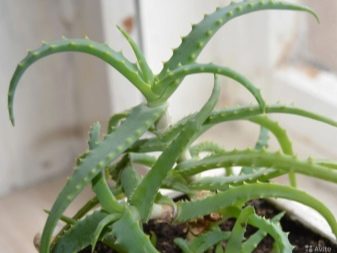

Description of differences from aloe vera and other species
In total, there are about 400 species of aloe. For medicinal purposes, two types are used - aloe vera and aloe vera. Aloe vera differs from aloe vera in several ways:
- Appearance. A centenary is a tree-like plant that has a trunk. Leaves sit on the sides of the trunk. Aloe vera looks more like a bush and is a rosette of leaves tending upward. Aloe vera leaves are wider, fleshy and thicker. The content of a gel-like substance in them is higher than that of the leaves of the agave.
- Structure. Among more than 200 nutrients, the polysaccharide acemannan is present in aloe vera. It is used in the treatment of oncology, ulcers and wounds. Agave leaves contain cell growth stimulants, under the influence of which all cells, including cancer cells, are activated. Therefore, this plant should not be used for oncology.
Useful properties and uses of aloe vera
Agave, like the agave, has the same chemical composition, however, according to doctors, its juice and pulp are best used for internal use.
Its beneficial properties are able to work wonders and have a beneficial effect on the body according to such criteria as:
- strengthening the cardiovascular system;
- restoration of the gums;
- improvement of the function of the urinary tract;
- strengthening the body's immune system;
- regulation of the amount of sugar in the blood;
- prevents the occurrence of heartburn and digestive disorders;
- reduces pain and inflammation in arthritis.
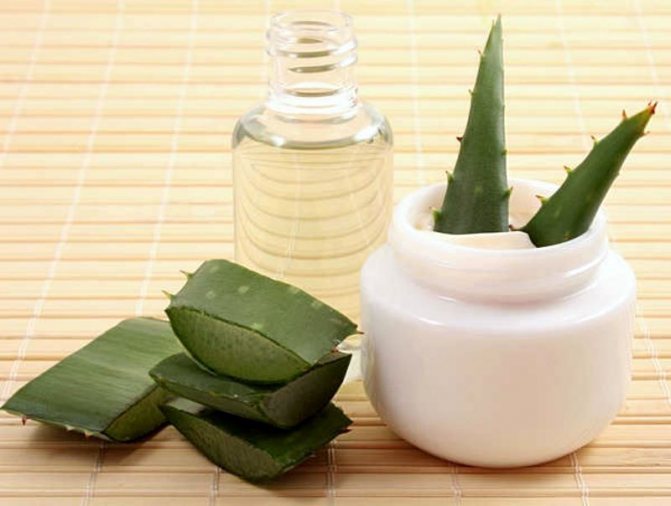

Biological description [| ]
The genus Aloe combines perennial leafy herbaceous, shrub or tree-like xerophytes and succulents.
The short stem (or trunk) is planted with thick fleshy xiphoid leaves, collected in dense rosettes and arranged in a spiral. In some species, the leaves reach 60 cm in length [7]. The edges of the leaves can be smooth or serrated, set along the edge with sharp spines or soft cilia. Leaves can store a large amount of water and grow considerably in size.
The leaves close the pores, which prevents the evaporation of water if it does not receive enough water from the outside. The pulp of the leaf is divided into characteristic cells that retain moisture reserves during drought.With prolonged drought, the leaf size visually decreases due to the consumption of the moisture reserve. Also, in adverse conditions, the plant sheds the lower leaves in order to preserve life.
DETAILS: Maiden grapes: planting and care
The flowers are small, tubular, white, red, yellow or orange, located on a long peduncle in an apical multi-flowered raceme.
Appearance
Aloe vera (Aloe present) has a wide leaf rosette with a diameter of 60 cm. The stem is so short that it may seem as if the leaves are growing directly from the ground. True, in the natural environment there are plants with a stem up to 80 cm.The stem of the Aloe treelike in nature can reach 4 m, but on the windowsill it rarely grows above 1 m.
The flowers of both types are cylindrical, collected in inflorescences on a long peduncle. But how, then, can you distinguish an agave from aloe vera? The first has bright red or orange flowers, while the second has yellow flowers. You can learn more about when and how Aloe Vera blooms here.
Below is attached a photo of flowers, in which you can see how the Aloe Vera flower differs from the usual agave or Aloe tree.
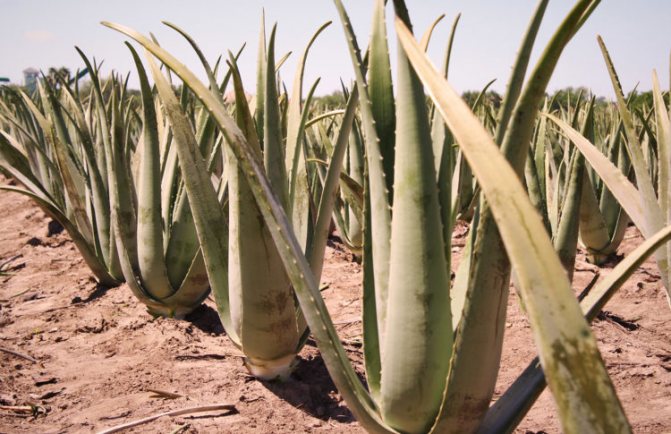

Photo of Aloe treelike:
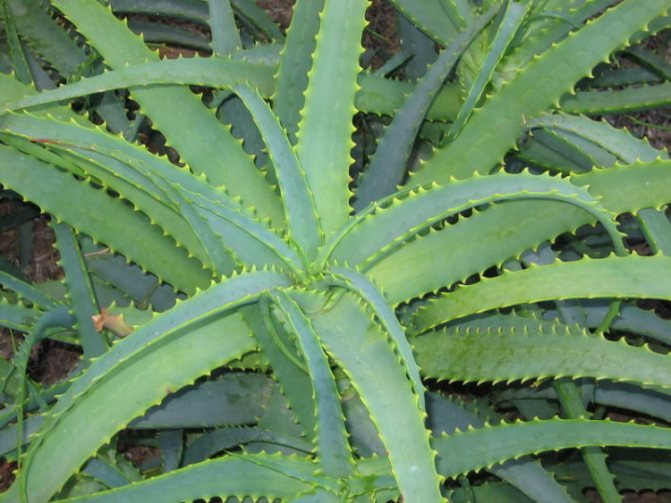

The healing properties of Aloe
Due to the fact that the treatment of aloe is of interest to many flower growers, we will briefly consider the healing properties of aloe. In medical practice, aloe leaves and juice are used, as well as aloe extract - dried aloe juice called sabur. Ancient healers wrote about sabur in treatises on medicine, it was used in the treatment of many diseases, and it was very expensive.
In modern medicine, aloe juice is also widely used. Biogenic stimulants are obtained from aloe juice, which are produced in living tissues (including plants) when exposed to unfavorable factors of the external and internal environment.
Now biogenic stimulants are obtained in industrial conditions. To do this, cut aloe leaves are kept in the dark at a temperature close to 0 degrees for 3 weeks, then juice is obtained, it is heat-treated, packaged in ampoules, which are used for aloe injection, ingestion and for external use.
The healing properties of aloe are used for a variety of diseases: diseases of the mouth, throat, respiratory organs, eyes, skin diseases, burns, purulent wounds, treats furunculosis and dermatitis, gastrointestinal diseases, diseases of the genital area, both men and women, and dr.
Aloe juice is widely used in folk medicine. It is active against many groups of bacteria: streptococci, staphylococci, diphtheria and dysentery bacilli. Aloe masks with various components are popular in cosmetology. These can be home-made preparations and a large number of creams, balms, gels of industrial production.
Aloes. Available in powder form. It has a strong laxative effect, which occurs after 8-10 hours of taking the drug internally.
Aloe juice. Liquid in vials. Used for dressings, stimulates the regeneration of the epithelium of the skin and mucous membranes. When taken orally, it improves digestion and has a laxative effect. It is used for rinsing for diseases of the upper respiratory tract, etc.
Aloe extract liquid and aloe extract for injection. It is used for eye diseases, for gastric ulcer and duodenal ulcer in the form of injections and for oral administration.
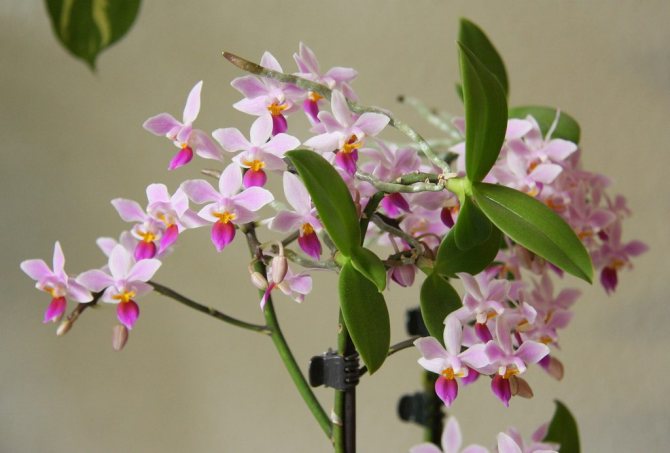

Aloe liniment. This is aloe juice with eucalyptus oil, castor oil, etc. It is used externally for burns and other skin lesions.
Aloe cream gel. A mixture of aloe juice with sea buckthorn oil, juice of plantain, yarrow, chamomile, sweet clover, burdock. It is used as a wound healing, anti-inflammatory, antiseptic cream for any type of skin.
Aloe syrup with iron. Used for anemia.
In addition to the aloe juice itself, aloe recipes contain lemons, walnuts, red wine, pine and birch buds, various herbs, mumiyo, propolis. Aloe is especially often used with honey in different proportions.
For the treatment and obtaining of aloe juice, it is advisable to use a plant not younger than 3 years old. Only the lower leaves need to be cut. Before cutting the leaves, it is advisable not to water the plant for a week.
Here are some recipes for aloe treatment.
Fresh or pharmacy aloe juice is taken 1 teaspoon or 1 dessert spoon 2-3 times a day 30 minutes before meals to improve digestion, increase appetite, for chronic constipation, gastritis. Outwardly used for dressings for burns, purulent wounds, furunculosis, dermatitis.
Aloe in combination with honey (½ part aloe, 1 part honey) with the addition of fish oil heals well infected and burn wounds.
A flatbread made from a mixture of aloe with honey and flour helps with abscesses on thick skin (on the soles, palms) and in the treatment of boils. There are many more recipes using aloe, but this is a separate topic.
We will definitely make a reservation that the treatment of aloe has its own contraindications. First of all, this applies to diseases accompanied by bleeding.
Hemorrhoids
,
menstruation
, uterine, gastric and other bleeding are absolute contraindications for the treatment of aloe. The treatment of aloe is contraindicated in diseases of the liver and gallbladder, acute inflammation of the gastrointestinal tract,
cystitis
.
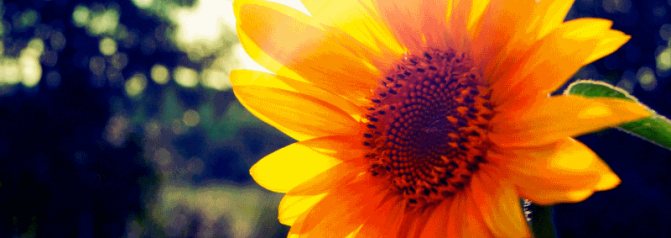

Fresh aloe leaves and juice contain many beneficial ingredients, including:
- aloin;
- minerals and trace elements;
- flavonoids, including catechins;
- organic acids;
- phytoncides;
- enzymes;
- vitamins, including vitamin C;
- tannins.
DETAILS: Varieties of cucumbers for open ground: what are the best and most productive with a photo
Aloe tree has such beneficial properties as:
- anti-inflammatory;
- bactericidal;
- wound healing;
- choleretic;
- laxative;
- fortifying;
- improving appetite;
- boosts immunity.
Agave benefits
The centenary is most often used for external use. For example, the juice and pulp of this plant:
- soothe the skin in case of inflammatory processes (eczema, acne, allergic reactions, etc.);
- help to draw out pus with abscesses;
- accelerate skin regeneration in case of burns;
- promote deep hydration of the skin and increase its elasticity;
- reduce redness and itching in case of bites from mosquitoes, wasps, gadflies, ants, etc .;
- help the disappearance of scars and stretch marks.
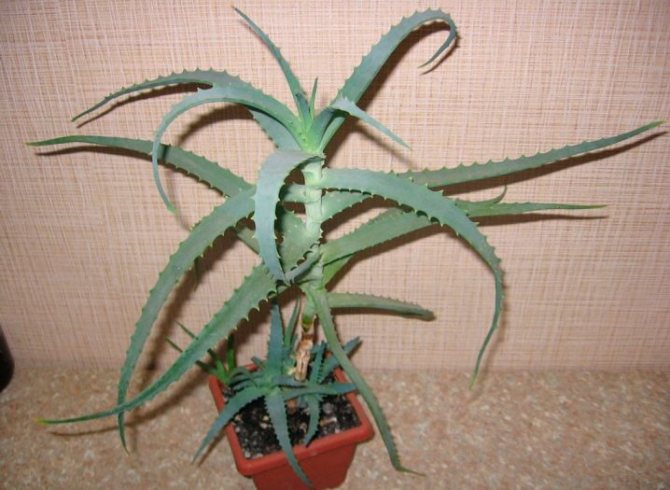

Distribution [| ]
Plants of the genus Aloe originate from the arid regions of South and tropical Africa, Madagascar and the Arabian Peninsula [8].
Aloe mostly grows in warm, dry climates, and it's no surprise that many people mistake it for a cactus.
Aloe can survive when other plants wither and die. This allowed Aloe to survive the harsh changes in the climate of our planet and survive to our times. In extreme situations, this plant closes the pores of the peel, trapping moisture inside the leaf. In the leaves of aloe, a fairly large supply of moisture is created.
Chemical composition and medicinal properties
Fresh aloe leaves and juice contain many beneficial ingredients, including:
- aloin;
- minerals and trace elements;
- flavonoids including catechin;
- organic acids;
- phytoncides;
- enzymes;
- vitamins, including vitamin C;
- tannins.
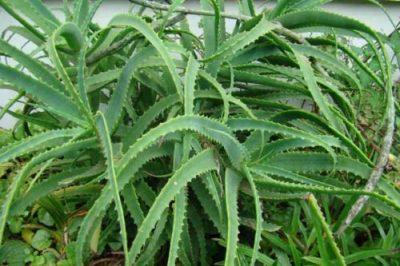

Aloe tree has such beneficial properties as:
- anti-inflammatory;
- bactericidal;
- wound healing;
- choleretic;
- laxative;
- fortifying;
- improving appetite;
- boosts immunity.
What diseases does it treat, how is it used?
Aloe tree juice is instilled into the nose with a cold. It is also used to increase the body's resistance to infectious diseases.
Agave-based products are taken orally for the following diseases:
- enterocolitis;
- gastroenteritis;
- chronic gastritis with low acidity;
- bronchitis;
- pneumonia.
Compresses with agave juice help with problems such as:
- burns;
- purulent wounds;
- lichen;
- trophic ulcers;
- lupus;
- lupus;
- radiation dermatitis of the head;
- joint diseases.
External use of the plant is also useful for cuts, boils, psoriasis, dermatitis, hair loss, excessive dryness of the skin. Whole aloe leaves, peeled, are applied to the corns. Crushed leaves and juice are used to treat periodontal disease.
Attention: For cervical erosion, use tampons moistened with aloe juice. The liquid extract is used for injections in the treatment of eye diseases, chronic gastritis, stomach and duodenal ulcers, and bronchial asthma.
You can read about the beneficial properties and contraindications to the use of the agave in a separate article.
Useful properties and application of the agave
Now it is worth taking a closer look at the beneficial properties of the agave and its scope. This type of plant is great for:
- get rid of boils and draw out pus;
- soothe an irritated spot with insect bites;
- heal wounds and cuts;
- restore hair follicles and enhance hair growth, as well as get rid of dandruff;
- improve complexion and smooth out wrinkles;
- get rid of varicose veins;
- heal ulcers and eczema, as well as ease the course of psoriasis;
- retain moisture in the skin due to the allantoin content.
Location
They love the sun, so it is recommended to plant in a sunny place. Wind protection (house walls, greenhouses, shrubs or trees) is also desirable. Wind protection will help keep the warmth these plants need. A sharp drop in temperature will inevitably lead to death.
The APG II (2003) classification system assigned the genus aloe to the Asphodeloceae family. The APG III (2009) classification system that replaced it included asphodelics in the Xanthorrhoeaceae family as a subfamily, the APG IV classification system (2016) returned the genus to the asphodelic family.
In traditional taxonomy, the genus was singled out into its own family Aloaceae (Aloeaceae, or Aloe), and sometimes it was assigned to the Liliaceae family. Close relatives of aloe are the genera Gasteria, Haworthia and Kniphofia, which have the same growth method, often in everyday life these genera are also called aloe. Sometimes "American aloe" is called American agave (Agave americana), although it belongs to a completely different family - Agave.
Contraindications
Any medicinal plant, in addition to healing properties, has contraindications. Aloe is no exception.
The use of tinctures, which include aloe, can promote vasodilation. Therefore, this succulent should not be used by people with low blood pressure. For the same reason, this plant should be excluded for pregnant women, as carelessness in use can cause bleeding. For wounds and cuts, aloe juice should be used only after the wound itself has been disinfected and washed out of pus. Otherwise, it can lead to the development of an inflammatory process.
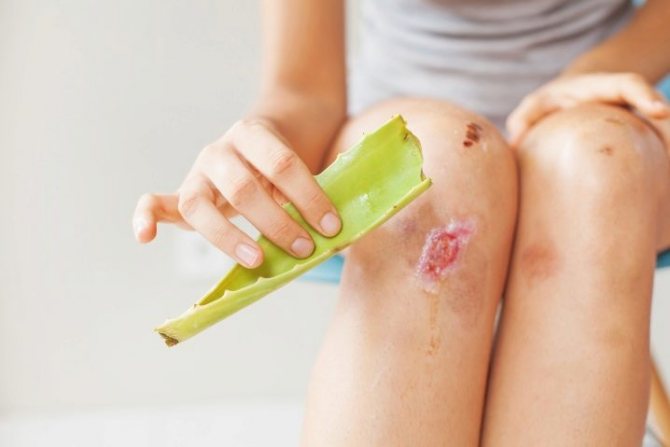

Botanical classification [| ]
Shrub up to 3 m tall. It is used in medicine. Most often, this particular species is called the agave. Shrub or small tree up to 3-5 m with a short branching trunk.
- Aloe tree
- Aloe aristata
- Aloe dichotoma
- Aloe hereroensis
- Aloe parvula
- Aloe peglerae
- Aloe maculata
- Aloe sophie
- Aloe speciosa
- Aloe striatula
- Aloe rauhii
Photo
In the photo below you can see what an indoor flower called aloe tree looks like.
How to care for this flower?
- Temperature. The optimum temperature in summer and spring is from 18 to 26 ° C, in winter - from 10 to 14 ° C.In summer, you can take the agave to the balcony. Leave for one hour at first, then gradually increase the time.
- Watering. In the summer season, moisten the soil once or twice a week, after the top layer has dried. In winter, reduce watering to once a month. Pour through a pallet, drain the remaining moisture. You can use the method of immersing the pot in water for 10 to 15 minutes. Be sure to drain off excess moisture. Use warm, settled water. Avoid waterlogging of the earth.
- Shine. The sill of the south window is preferred. Provide good illumination, but protect from direct sunlight. In winter, arrange backlighting with fluorescent lamps.
- Pruning. It is necessary to remove damaged, dried and diseased leaves. The sheet is cut with a sharp knife at the base. Usually the outermost leaf plates are removed - they are the oldest. Several lateral shoots can be removed to shape the flower. If there are many young shoots five or more centimeters long around the main plant, they are separated along with the roots.
- Top dressing. From March to September, liquid complex mineral fertilizers are applied for succulents and cacti. The frequency of the procedures is once or twice a month.
- Pot. A clay pot with multiple drainage holes in the bottom is ideal. You can choose a plastic container. When transplanting, take a new pot one fourth more than the previous one. The distance from the roots to the walls should be three to four centimeters. Before filling the pot with drainage layer and substrate, it must be washed and disinfected.
- Transfer. A young agave is transplanted every year in the spring. After reaching the age of three years, the procedure is carried out every two to three years. A special soil suitable for cacti and succulents.
DETAILS: What can be made from puff pastry: recipes and photos of delicious pastries
Healing perennial care
Any houseplant requires increased attention, caring for it can be quite complicated or simple, like, for example, aloe. The flower tolerates temperature changes perfectly, feels good in ordinary home conditions. In summer, it can be taken out into the open air, placed on window sills, balconies, terraces. Without loss, the home doctor also tolerates direct sunlight, but without proper lighting, his leaves can become pale and thin.
Does not have a flower and special requirements for watering, 1-2 moisturizing per week is enough. When watering, care must be taken that water does not fall on the surface of the outlets, and the soil does not become waterlogged, as this can lead to decay of the roots. Spraying is not required either, you just need to carefully wipe the leaves from dust and dirt. Aloe blooms at home rarely, for this there is no need to create any special conditions.
High season breeding
Breeding aloe is best planned in the spring or late summer. This period is considered the most favorable for successful rooting.
Breeding methods for homemade aloe:
- the use of basal shoots formed at the base;
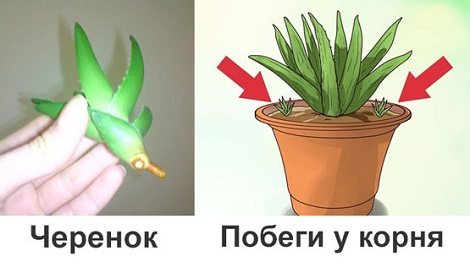

Reproduction of aloe - cuttings;
- using tops with a pair of leaves;
- seeds are rarely used, as this growing method is considered problematic.
The most active plant is taken into growth when using basal shoots. The selected baby is carefully pinched off and sent to a glass of water until roots are formed, then transplanted into a suitable soil.
When grafting, cut off a part of the leaf 10 cm long, and keep it at room temperature for a day. Before planting, the cut is sprinkled with crushed coal so that the stalk does not rot. Deepen the workpiece in the sand by 1-2 cm. In 2-3 weeks, the root system will form, then it will be possible to organize a pot transplant.
If aloe has grown many stem shoots, then some of them are cut off and sent to a container with water.This method is relevant for the rejuvenation of old specimens, in which the main part of the lower leaves is used for treatment. It is recommended to replant young plants once a year, and after three years - once every 2-3 years. In some cases, you can limit yourself to replacing the topsoil.
Transplant frequency and rules
This procedure requires compliance with certain conditions. You can transplant already adult plants 2-3 years old and young ones into a larger pot as they grow. The pots can be simple plastic ones, but ceramic is the best option. The soil is suitable for succulents with such a composition: two parts of sod land, one part of leaf, one part of humus and coarse sifted sand. Broken brick is used for soil looseness and drainage, and charcoal is used for disinfection.
It is necessary to fertilize the soil after transplanting in 2-3 months; for this, liquid mineral supplements for succulents are used. Watering at this time should not be abundant, as it dries out, otherwise the root system will rot. It is advisable to expose the plant to the open air.
Caring for aloe, despite its apparent simplicity, has some difficulties, which are mainly associated with waterlogging of the soil. At the same time, the leaves become pale, and the root system begins to rot.
Soil preparation for planting
It is difficult to treat such consequences, therefore, at the first sign, the flower pot should be placed in a warm and well-lit place, watering should be sharply limited. If this does not help, then it is necessary to examine the roots. Only light and elastic areas are left, softened and darkened areas are completely removed. If the entire root system is affected, you can try to root the apex. Often, with improper watering, dry rot appears, the plant in this case dries up from the inside. When watering with cold water, the leaves begin to fall off the succulent.
Top dressing taking into account the growing season
Aloe perennial belongs to succulent plants, characterized by unpretentiousness in cultivation and care, but without top dressing it will be problematic to achieve gorgeous flowering. With a minimum amount of nutrients in the soil, the plant will form few buds, and they will eventually fall off without opening. Therefore, the selection of the necessary fertilizers should be taken care of in advance.
From May to August, it is recommended to use mineral complex compounds in liquid form. Fertilizers are applied once every 14-20 days, while the earthen lump must be soaked in water. Care must be taken not to get the nutrient solution on the leaves and stems. It is allowed to fertilize perennials by immersion. The nutrient composition is poured into a tray and a home flower is placed in it.
Young plants do not need additional fertilization during the first 6 months. It is unacceptable to feed specimens affected by excess moisture or pests. First, the plant must be cured, and only then provide it with additional nutrition.
Does the flower have pests?
Despite its resistance, the plant can be seriously affected by several pests:
- The negative activity of the spider mite is reflected in the change in the color of the foliage. At an early stage, the leaf blades acquire a yellow tint, at a later stage - scarlet. If a spider mite has looked into a visit, then a barely noticeable cobweb can be found on the foliage. For treatment, only specialized drugs are suitable - acaricides. Aktellik, Masai, Oberon are considered popular. As a prophylaxis, a tincture of garlic is used for spraying or aloe is treated with a solution of water and alcohol.
Scabbard on the stem - The main sign of the presence of a scale insect is the drying of the leaves and the appearance of brown spots on their surface. On a green surface, the pest stands out noticeably and resembles a brown plaque.Defeat with a scabbard requires an urgent transplant of aloe into another container and treatment with a special agent. A good option is a mixture of engine oil and soap solution in equal proportions. The plant is completely treated with the composition, after which it is wrapped in film and left for several hours. Repeat the procedure if necessary.
Sometimes the flower doctor is attacked by a red spider, midges may appear in the ground. Such a plant must be exposed to fresh air or good ventilation in the room. It is recommended to treat the foliage surface with water or alcohol.
Of the most dangerous diseases, it can be noted:
- Signs of negative activity of root rot are plant shrinkage and growth retardation due to root damage. It is difficult to recognize the disease, and aloe can be saved only at the initial stage. Having found rot on the roots, you can try to preserve the healthy parts by removing the diseased ones. The remaining roots are sprinkled with charcoal or sulfur. Without fail, perennials are transplanted into new soil with a significant proportion of sand in the composition (2: 1). Watering is resumed after 3 weeks. In case of complete decay of the roots, it is worth trying to separate the top and root it, and then transplant it into a new container.
- Dry rot is dangerous because it is almost impossible to identify it. The affected aloe begins to dry out from the inside, while maintaining a completely healthy appearance. The only way to save yourself from the disease is prevention, which is suitable for spraying the foliage with any fungicidal preparation. Alirin B, Gamair, Glyocladin, Raek and other agents are used as the main fungicides for the treatment and prevention of diseases.
Video about the features of growing and using tree aloe.
Remember:
- The home doctor does not get along well with a lot of other plants around, he loves space.
- Adequate light must be provided for the plant to be brightly colored.
- In the summer, you should organize regular feeding, and when watering, make sure that the water does not settle in the sockets.
Breeding types, their advantages and disadvantages
Basic methods:


With the help of processes - children. A simple way that does not require complex procedures. Allows you to get several young plants. However, you need to wait a long time for new appendages to form.- Sheet. A very practical method. Rooting takes place directly in the substrate.
- Cuttings. You can root the cuttings in water, but it is better that the rooting takes place in the soil. Fragile cuttings can get sick or be attacked by pests. In most cases, reproduction is successful.
- Seeds. Quite a complicated and time-consuming process. Take a lot of time. It takes a year to get a full-fledged young plant. The method is highly effective. A large number of new specimens can be grown at the same time.
- The top. Quite the simplest and fastest way.
Annual sunflowers are propagated by seed. But perennial bushes must be divided. This is done in the spring or before winter. Carry out such a procedure no more than once every two years.
Sunflowers
If the climate is warm and humid, then the seeds can be planted in late fall. For the middle lane, this option is not suitable, so the optimal time for planting is the beginning of May. Every half a meter, it is necessary to sow 3-4 seeds. Seedlings will appear in about a week. Keep in mind that frost will kill sunflowers. Therefore, it makes sense to wait until mid-May to exclude the possibility of negative temperatures.
Diseases
With improper care and non-observance of the conditions necessary for the plant, the aloe can get sick. Consider the main diseases and how to deal with them.


Leaves turn yellow... Reduce watering. Use warm, settled water.- The tips of the leaves dry... The plant needs a transplant.
- Leaves curl... Hygiene is impaired.The accumulated dust should be regularly removed from the leaves with a damp cloth.
- Root rot... The reason is excessive watering and low air temperature. The agave can be saved only at the initial stage of the development of the disease. The plant is removed from the flowerpot, the decayed areas of the roots are removed, the cuts are treated with crushed coal and transplanted into a substrate with a high content of sand. If the root system is completely rotten, the healthy top of the agave is cut off and used for reproduction.
- Dry rot... It is almost impossible to determine the onset of the disease in time. The only measure is spraying with antifungal drugs as a prophylaxis.
Flowering and actions in its absence
In its homeland, the aloe tree blooms annually. In indoor conditions, flowering occurs extremely rarely, while the peduncle is much shorter, and the flowers are smaller. The plant is able to bloom only if it is already ten years old.
If an adult agave does not bloom, follow the algorithm:
- In the summer, gradually accustom the aloe to life on the balcony or veranda. Water once or twice a week with warm water. Don't forget to fertilize.
- With the onset of autumn cold weather, bring the agave into the house. Place on a lighted window. Water once a week.
- When the active growth of green mass stops, arrange a cool, semi-dry winter. Keep in a room with a constant temperature of 10 to 12 ° C. Provide 12-16 hours of daylight per day. Use additional lighting with special lamps. Moisten the substrate once a week.
If the agave pleases with flowering in winter, it can last up to six months. After flowering, the peduncle is carefully removed.
Natural habitat
It will be useful to figure out where the natural conditions familiar to plants are. Initially, cultures loved the South African climate for its high temperatures and dry air. In the wild, aloe vera and agave can be found in deserts and semi-deserts, as well as in the tropical climate zone.
Due to its unpretentiousness and exceptional medicinal properties, aloe quickly became popular all over the world. Now it can be found in almost every country. At the same time, the culture perfectly adapts to completely different conditions.


Many will be surprised, but being in natural habitat, aloe reaches from 2 to 3 meters in height and even blooms. But, getting into a closed room, where a significant part of food sources disappears, the plant almost does not bloom and has an order of magnitude smaller.
An interesting fact should be noted. In 2011, Italian scientists conducted experiments on various types of aloe. After analyzing the results, they came to the conclusion that the amount of beneficial properties in indoor samples is twice that in those that grow in the wild.
Notes [| ]
- ↑ For the conventionality of indicating the class of monocots as a superior taxon for the group of plants described in this article, see the APG Systems section of the Monocotyledonous article.
- ↑ Information on the genus Aloe (English) in the Index Nominum Genericorum database of the International Association for Plant Taxonomy (IAPT).
- ↑ 12 According to The Plant List, the genus Aloe contains 558 species.
- ↑ Balashon-Hebrew Language Detective
- ↑ Douglas Harper, Online Etimology Dictionary, 2001-2012
- ↑ Centenary // Great Soviet Encyclopedia: [in 30 volumes] / ch. ed. A.M. Prokhorov. - 3rd ed. - M.: Soviet Encyclopedia, 1969-1978.
- ↑ 123Encyclopedic Dictionary of Medicinal, Essential Oil and Poisonous Plants / Comp. G. S. Ogolevets. - M .: Selkhozgiz, 1951. - S. 15 .-- 584 p.
- ↑ Aloe
- ↑ Kovaleva N. G. Treatment with plants. Essays on herbal medicine. - M .: Medicine, 1972 .-- S. 3. - 352 p. - UDC-615.322
- ↑ For example, aloe-based Fruiting drink (inaccessible link)
- ↑ Aloe (unspecified) (inaccessible link). Retrieved September 11, 2016. Archived September 17, 2019.
- ^ Dat A. D. et al. Aloe vera for treating acute and chronic wounds. // Cochrane Database of Systematic Reviews. - 2012. - Issue 2. - Art. #: CD008762. DOI: 10.1002 / 14651858.CD008762.pub2.
- ↑ Handbook of the Practitioner. - M .: Medgiz, 1956 .-- T. 2.- 655 p.
- ↑ Norov A. Travel in Sicily in 1822. - SPB, 1828 .-- S. 88.
Landing
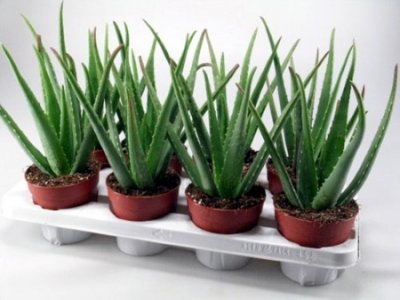

The best soil for aloe is a mixture of equal parts coarse sand, humus, leafy earth and two pieces of turf. You can add charcoal to the composition as a disinfecting component and broken brick for looseness. The soil should be slightly acidic. You can buy substrate for succulents and cacti in stores. For planting, it is better to choose a low but wide pot.
You can read more about the features of planting aloe here.
Other differences
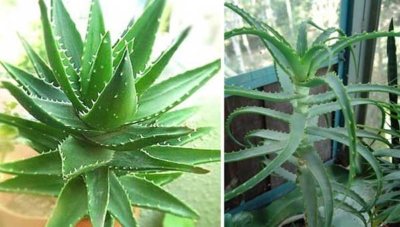

There are other differences between the varieties of aloe. These are contraindications.
- Agave should not be used for diabetes, problems with blood pressure, blood vessels. Aloe vera is not recommended during pregnancy either.
- But the agave is contraindicated only in oncology (the enzymes that make up the composition promote the growth of malignant cells).
Knowing what is the difference between aloe vera and an agave, you can understand what type of crop is needed for home cultivation and further use. But keep in mind that both plants are a real treasure of nature. Among the variety of other plant forms, it is impossible to find a green healer more valuable for health.
If you find an error, please select a piece of text and press Ctrl + Enter.
Pruning
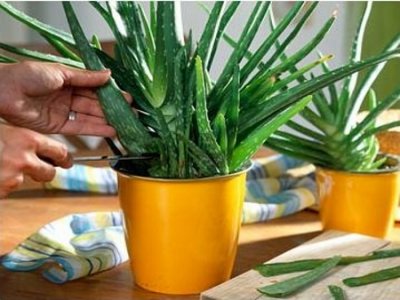

Aloe requires regular removing dried or damaged leaves. Leaves that have lost their color must also be removed. If pests have appeared on the foliage, such leaves must also be removed.
Can shape dimensions plants by removing side shoots. When new shoots appear, they are removed along with the root so that they do not take energy and nutrients from the mother plant.
With regular care, the aloe will not only look well-groomed, but also have the required dimensions. But if you take care of aloe incorrectly, then diseases can develop. Read more about diseases and pests of aloe here.
Soil and top dressing


Charcoal and brick chips are added to the soil where the aloe will grow.
Or buy a substrate.
Fertilizing with mineral fertilizers is performed 2-3 times a year and only in summer.
You can use a top dressing for cactus plants. It is recommended to add it to wet soil 1 time in 3-4 weeks. Fertilization should start in April and continue until the end of September.
Output
Both plants are very similar. They are real home healers. A sure sign of the leaf's readiness to be of use is its dry tip. This means that he has absorbed all the valuable substances. Before using aloe, it is better not to water for several days, after which the leaves are placed in the refrigerator for 7 days. These manipulations will help activate all the substances, which will make the plant more useful.
Aloe is not whimsical in cultivation and is able to grow even where there is not enough moisture, light and heat.
Plants Comment
How to determine the age of an aloe?
There are several ways to determine the age of aloe:
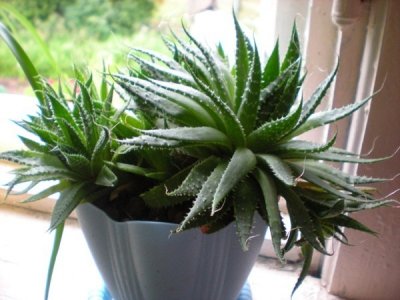

- Using a ruler
If the height of the plant is about 20 cm, we can say that the agave is more than 3 years old;
- According to the growth of leaves
It is necessary to calculate how many leaves a plant has appeared in six months. This number is multiplied by two. Divide the number of all leaves by this number. The result is the age of the plant, measured in years.
Aloe is a unique plant with a whole range of medicinal properties. The plant is not demanding, it is easy to care for it. Aloe loves warmth and light, perfectly tolerates heat and lack of watering... Grows rapidly in the first year, but rarely blooms at home. When blooming, it gives an arrow with an original bright color of a rich shade. Due to its medicinal effect, this plant is very popular among flower growers.
Lighting
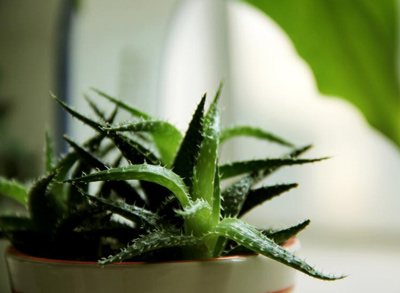

Aloe is one of those indoor plants that love light very much.
So choose for it the brightest place in your home.
In addition, it is necessary to often turn the plant towards the light - twist it in one direction or the other.
Otherwise, the trunk will bend.
Contraindications for aloe vera treatment
And active substances in the composition of aloe vera juice reduce blood sugar levels. Therefore, people with low blood sugar (diabetics) it is not recommended to use drinks (tinctures) from aloe (agave) juice. You also need to be careful. people with a tendency to spasm of blood vessels and with hypotension (low blood pressure), because aloe juice promotes vasodilation. For the same reason, it is not recommended to drink aloe juice. pregnant women - there is a risk of severe bleeding.
What does medicinal aloe look like? Medicinal types of aloe
The genus of aloe is numerous xerophytes and succulents. Perennial plants in nature are found in the form of herbaceous leafy, shrub and even tree-like forms. There are a lot of varieties of aloe, but they all come from the tropics of southern Africa, Madagascar and the Arabian Peninsula.
The main feature of aloe is its thick, xiphoid leaves. It is in them that the plant accumulates moisture, which allows it to survive drought and other disasters of nature. In difficult weather conditions, aloe closes the pores of the skin, due to which the water accumulated in the leaves remains for quite a long time, without evaporating or drying out the plant.
Various types of aloe can be found on sale, but many of them are decorative flower forms. Only two types have healing qualities - Aloe Vera and Aloe tree.
Aloe vera
Aloe vera (Aloe vera) - one of the types of plant, which would be more correct to call aloe present. But both names are used equally.
Aloe is a short-stemmed succulent plant. Thick, fleshy leaves form a dense rosette, which naturally grows up to 60 cm in diameter. Aloe vera leaves are gray with small spots on the surface. The edges of the leaf plate are covered with small thorns. The root system is poorly developed. Aloe vera flowers are tubular, of different shades of orange, but you can see them only in natural conditions - your "doctor" will not want to bloom on the windowsill.
Aloe tree
Aloe arborescens (Aloe arborescens) can be in the form of a tree or shrub and in nature often reaches five meters in height. The trunk is covered with long fleshy leaves with soft thorns along the edges. In an adult plant, the lower leaves fall off, and the bare trunk is covered by numerous basal offspring, making the aloe look like a spreading bush.
During the flowering of the aloe, a long panicle appears with bright orange flowers. When kept at home, it rarely blooms, and the size of a houseplant is much more modest.


How does aloe differ from Kalanchoe?
Aloe and Kalanchoe belong to different families: Asphodel (monocotyledonous) and Tolstyanka (dicotyledonous), respectively. The difference in morphology and other features of the taxon determine how the aloe differs from the Kalanchoe. The habitat is similar. Often found as indoor crops.
Kalanchoe Degremona belongs to the medicinal varieties. Its straight stem does not branch, the lanceolate leaves grow at a slight angle relative to the stem and have teeth. An interesting way of reproduction is associated with the teeth: buds appear between the teeth, which germinate into daughter plants. When the buds enter the soil, rooting occurs.
In terms of chemical composition, the agave and Kalanchoe are similar:
- organic acids (including malic acid);
- polysaccharides;
- carbohydrates;
- vitamins;
- trace elements;
- flavonoids.
The combination of such elements determines the range of application as an anti-inflammatory agent, for burns, and other skin diseases. Centennial is used for the same, but is more widespread in pharmaceuticals.
Description of aloe
Aloe is a succulent evergreen plant (Asphodel family) of the genus Aloe. Among the people, it is more often called an agave.The plant is cultivated at home as a medicinal and ornamental one.
Under natural conditions, it looks like a tree, strongly branching and sometimes reaching 5 meters in height. In domestic conditions, the plant rarely exceeds a height of 100 cm, and grows like a bush. Its cylindrical root is highly branched, gray-orange in color. When grown in a pot, the trunk is almost absent. Under natural conditions, a well-developed branching trunk can be up to 30 cm thick.
The alternate fleshy leaves are greenish-gray, with a prickly jagged edge. The surface is matte, smooth. The inner part of the leaves contains a special gel-like structure that the plant needs as a reserve of liquid. For humans, it is of value due to its good medicinal properties. The leaves can be up to 60 cm long.
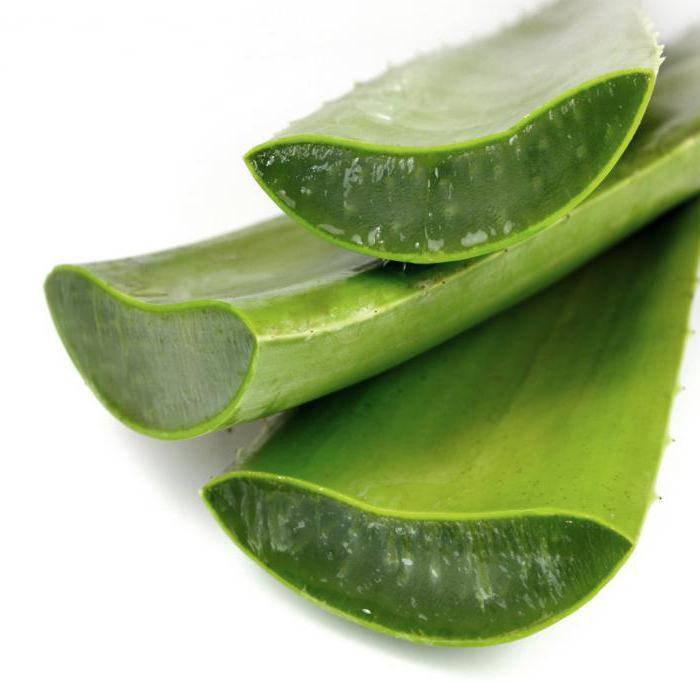

Bell-shaped flowers are large, tubular, drooping, collected in axillary inflorescences up to 50 cm in size. The flowers are white and sandy with a distinct orange midrib on the petal. Aloe bloom is rare even in nature, but practically does not occur under domestic conditions. Fruits are cylindrical boxes.
How did aloe and agave from tropical countries come to us?
Until today, heated discussions of scientists and specialists flare up around this issue. Accordingly, there is no consensus. According to the hypotheses put forward, the aloe could have come to us from one of the three further presented places: South Africa, Madagascar or the Arabian Peninsula.
- At a time when these places were dying from the fiery heat, drought and the absence of the slightest drop of water, all the plants withered and died. And only aloe could not only survive, but also spread to other continents.
- The first mention of this plant and its unique medicinal properties was recorded in the ancient Egyptian chronicles of a medical nature, which date back to about 1500 years. BC. This was done by a German scientist and writer named Georg Ebers, who at that time was studying the features of Ancient Egypt.
- Another interesting historical fact. Alexander the Great himself strove to conquer the island of Skrot (which he successfully achieved) for the sake of one main goal - to become the owner of a large number of aloe plantations, so that he could use this miracle remedy in numerical campaigns.
There is also a slight difference in this matter between these species.
- We will not touch on each species with its history of origin separately, but the aloe tree in the truest sense of the word takes its roots from South Africa. More precisely, from South Africa, Zimbabwe and Malawi.
- But the real aloe comes from the Arabian Peninsula. It also grows widely in the Canary Islands and Sudan.
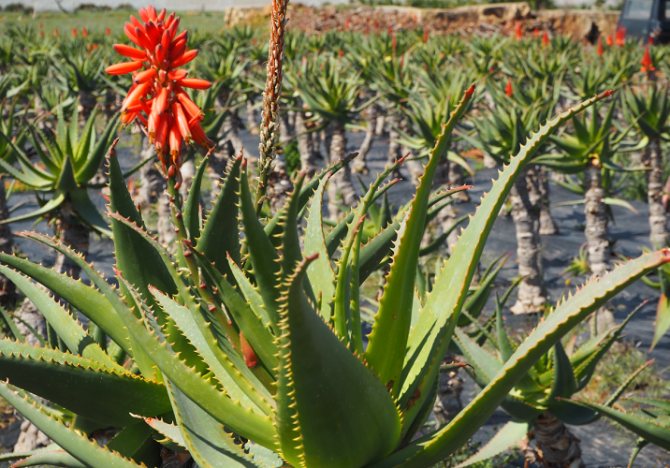

Such succulents are native to tropical countries with hot climates.
For external use (aloe vera):
- heals ulcers and eczema;
- soothes dermatitis;
- pulls out acne, boils;
- accelerates tissue regeneration in case of burns and frostbite;
- helps with varicose veins;
- moisturizes the skin due to the large amount of allantoin;
- reduces wrinkles, helps restore skin structure;
- soothes itching in insect bites;
- helps with baldness, dandruff, in combination with honey, returns vitality to hair;
- heals wounds and cuts resulting from shaving;
- helps to smooth out postoperative scars and stretch marks of the skin.
Watering, humidity
Even in summer, aloe does not need much water. Watering should be moderate... The optimal frequency is once a week. In winter, on the contrary, rare watering will be enough.
In general, the plant is very sensitive to waterlogging of the soil. If water stagnates in the pot, the roots can fester and the aloe will die.
How to determine if a plant has enough water? When watering, pay attention to the presence of moisture on the pallet.If the moisture has settled, then there is enough water. Pour it out and stop watering.
general information
How is aloe vera different from aloe? As noted above, this is also one of its varieties. And all types have some kind of peculiarity.
The homeland of aloe is the southernmost tip of southern Africa. It is there, in favorable natural conditions, the plant grows up to 3 meters in height. The home environment does not quite correspond to the native climatic conditions, therefore it grows much smaller in size and practically does not bloom. In connection with the latter, the people called him a century-old.
There are approximately 400 plant species in total. Two types have more pronounced useful and medicinal properties for people: aloe vera and agave.
Their external differences are insignificant. Aloe vera has a shorter trunk and its leaves are directed upwards, and the appearance of the tree-like variety corresponds to its name - it resembles a tree with a sufficiently developed trunk. More details about the differences will be described below in the article. For all of us, the agave, which is often found on home windowsills, is more familiar.
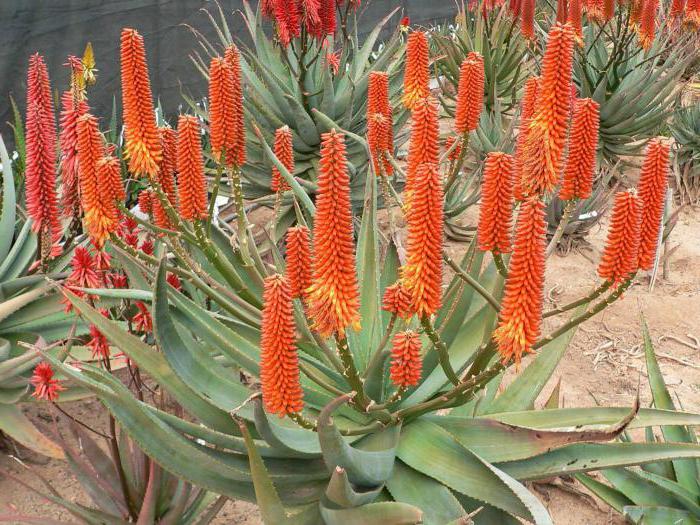

Aloe camperi has medicinal properties. Varieties of aloe: types of medicinal and decorative aloe
Aloe is a popular perennial of the Asphodel family. The plant is often called the Centenary among the people because of its rare and short flowering. The flower gained its popularity because of its great decorativeness and unpretentiousness.
Like other succulents, aloe can go without water for a long time, grow in the most unfavorable conditions. In total, about 400 varieties of this interesting flower are known. In this article, we will look at the popular types of aloe and their medicinal properties.
Decorative views
Naturally, aloe is often found in the Arabian Peninsula and Madagascar, Africa. Wild-growing individuals differ from decorative ones with a large and spreading bush. Some specimens reach 15 meters in height. Indoor aloe is much smaller, as a rule, it is a small bush that easily fits into room conditions. Below are the most interesting decorative types of aloe and their photos.
Aloe variegated (brindle)
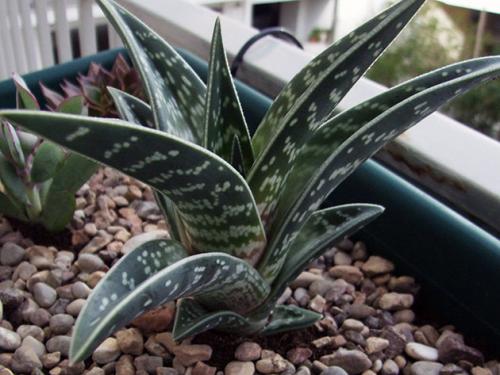

It is represented by a bush up to 30 cm high and a shortened stem. The leaves are triangular in shape, arranged in a spiral of three rows, forming a neat rosette. Has a characteristic two-tone spotted color.
Sometimes even at home in mid-spring tubular inflorescences of orange or bright red color are formed. Flowering occurs only at 4-5 years of age. Aloe tiger is unpretentious in care, grows actively in any conditions. Suitable for beginner growers.
Aloe Marlota


It is a tree-like shrub that can grow up to 4 meters in height. Leaves are large and green, slight reddening of the thorns is permissible.
Flowering occurs only at 5-6 years of life, the inflorescences are painted in a bright yellow or orange hue. At home, it grows very slowly, practically not susceptible to diseases and pests. Able to do without water for a long time.
The flower was named in honor of the researcher of the flora of Africa; in the homeland of aloe, this species can form whole impenetrable forests.
Aloe pretty (premium)
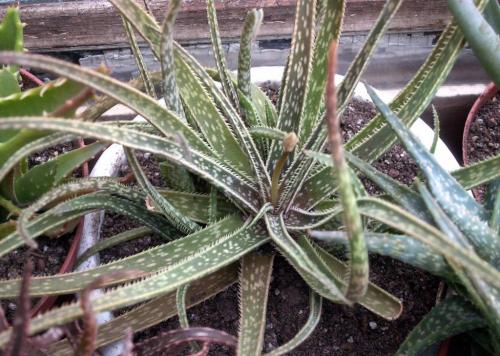

A herbaceous stemless perennial found in Madagascar. The leaves are collected in a volumetric rosette with a diameter of up to 15 cm. There are small thorns on the leaf plate, the leaves are covered with white bumpy spots. Flowering is extremely rare. Inflorescences resemble bells, are painted in coral color.
Aloe squat
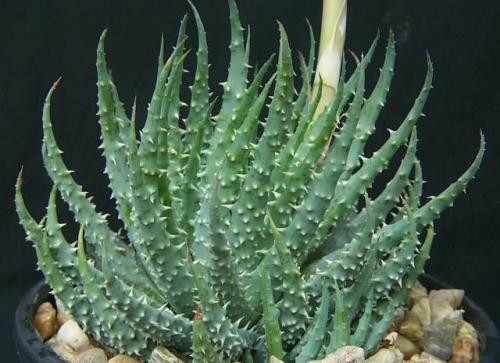

This is a herb that growers fell in love with for its unusual linear-lanceolate leaves with characteristic teeth. They do not exceed 15 cm in length, but in comfortable conditions they can become very wide (a similar effect occurs with some cacti).
The leaves are colored gray-green or green-blue; as they grow, they gather in dense groups.Flowering is observed from 3-5 years, the flowers are small, bright red. In its natural environment, it is found only in South Africa.
Aloe spinous


The species is represented by a small bush up to 1 meter high. A large number of gray-green leaves with a white speck are collected in a characteristic rosette in the form of a hemisphere, the diameter of which can reach 60 cm. There is a slight roughness on their surface. The plant begins to bloom from 3-4 years of age, the flowers are painted in a pale orange color.
The flower is often confused with the striped Haworthia, but the aloe has a characteristic spine at the end of the leaf.
Aloe Jackson


In the wild, it is ubiquitous in Somalia and Ethiopia. The decorative variety is characterized by a small height (up to 25 cm) and less spreading. A short-stemmed bush with linear and very narrow pale green leaves, at the end of which there is one small thorn. They have a pronounced waxy coating.
Aloe Descoings
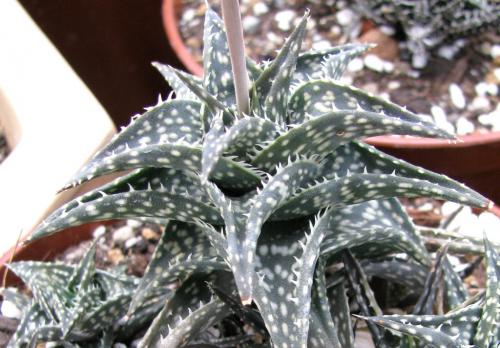

One of the smallest varieties of aloe. The plant is represented by a shortened herbaceous stem, on which root shoots are formed over time. Green leaves of a dark or light shade are collected in a root rosette in the shape of a star.
Each leaf surface has white specks and waxy tubercles. Under favorable conditions, tubular orange flowers are formed on a simple peduncle. In the wild, it is found in Madagascar.
Ornamental varieties of aloe do not have medicinal properties or they are less pronounced. However, some species and varieties have become known precisely for their medicinal properties.
Medicinal species
A large group of the Asphodel family, known for their medicinal properties. The healing qualities of aloe have been known to people since time immemorial. According to some researchers, the plant has been used to heal wounds and skin diseases since the Neolithic era. Today, even indoor varieties can be used for medicinal purposes. Consider the descriptions of the most useful types of aloe and their names.
Aloe Barbados


It is a type of aloe vera. It is represented by a perennial shrub growing in South Africa. Leaves of light green color with a strong serration form up to several rosettes on one bush. The pulp of adult plants of this species is widely used in the composition of gels for the treatment of dermatological diseases, has a regenerating effect.
Aloe soapy (spotted)
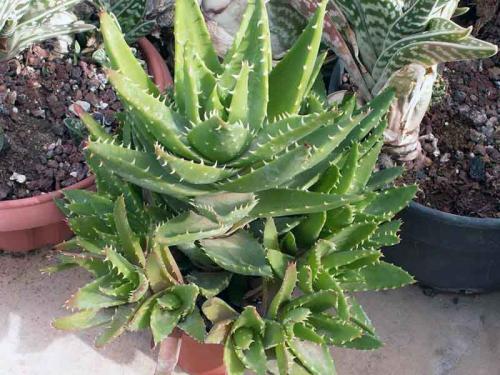

The bush is undersized, does not exceed 70-90 cm in height. Branching stem with several leaf rosettes. Dark green leaves with white dots can grow up to 60 cm long and up to 6 cm wide.
The leaf plate is thin, has a flat-curved shape, there are thorns at the edges. It is used to treat skin diseases, especially in chronic diseases. Less commonly used in natural nasal drops.
Aloe tree


The most common type of aloe, found in almost every home. It is this species that is popularly called the Centenary - according to legend, flowering can be seen once every 100 years.
Outwardly, it is represented by a bush that grows up to 3 meters in height (see photo). The stems are branched; with age, they are often bare in the lower part. Rosette leaves, very dense. They have a curved xiphoid shape, can reach a length of up to 6 cm. There are powerful thorns from the edge of the leaf plate, in some specimens they exceed 3 mm in length. At home, flowering is rarely observed, the inflorescences are racemose, red or yellow.
The pulp and juice of this type of aloe has a powerful regenerating and antiseptic effect, therefore it is often used in drops, ointments, gels and other medicines.
Aloe Vera (present)
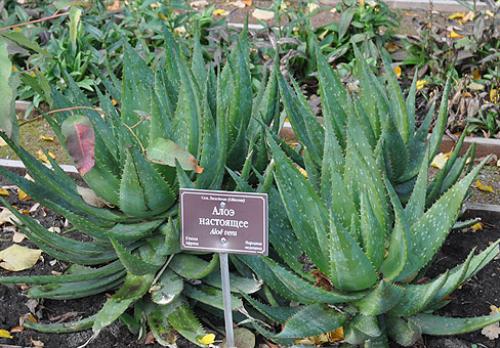

This type of aloe has been used in folk and traditional medicine since ancient times.It is used in cosmetics, as well as anti-inflammatory and antiseptic preparations for external and internal use. The plant is grown on special plantations that can be found in China, America and some countries in East Asia.
It has powerful and fleshy leaves, reaching 100 cm in length and 15 cm in width (see photo). The color of the leaf plate can be green or blue, depending on the variety. Blue Aloe Vera grows and ripens faster, they do not differ in properties.
Aloe scary (terrible)
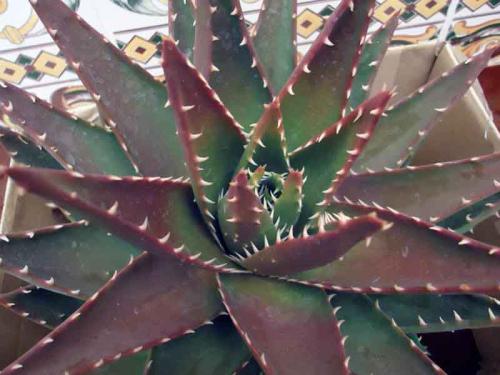

A rare species of aloe. It is a massive plant that can grow up to 3 meters in length. The bush is straight and separate, on which there is a rosette with powerful and wide leaves.
They are usually colored light green, but slight redness may appear (see photo). Aloe of this species got its name because of pronounced thorns that can sprout right in the center of the leaf blade.
In South Africa, this plant is grown for juice, which is used for the production of pharmaceutical and cosmetic products.
Beneficial features
The juice and pulp of the leaves contains a large amount of vitamins, essential oils, simple acids, as well as flavonoids and phytoncides. The chemical composition of aloe is a real storehouse of nutrients. It is widely used in traditional and folk medicine for the treatment of diseases of the digestive, visual and respiratory systems, as well as the skin. For medical purposes, fresh and evaporated juice (sabur) of adult plants is used, since it is in them that the content of nutrients is maximal.
Despite its beneficial properties, aloe can cause tremendous harm to the human body, for example, the juice of young leaves and some species causes severe poisoning, and can also lead to kidney problems and miscarriage during pregnancy.
Aloe is a very common plant, loved by flower growers for its unpretentiousness, decorative qualities of leaves, as well as useful properties. When choosing a type, you need to take into account the characteristics of the leaf plate and the height of the bush.
Home use of aloe
To use the plant for medicinal purposes, you should carefully tear off the leaves from the stem, wash, wrap in a napkin and put in the refrigerator for 5-7 days. Later, you should cut off the thorny edges of the leaves, remove the pulp and use.
- Aloe for acne and pimples. With an additional astringent and drying effect, the plant is ideal for treating acne on the face. You can rub the pulp of the leaves or make a lotion for daily use. Store this lotion in the refrigerator.
- Aloe Vera scrub (mask) for problem skin: is very effective to get rid of dark spots and pigmentation. You can use this simple scrub to solve this problem. You will need two tablespoons of fresh aloe, two tablespoons of oatmeal, one teaspoon of cucumber juice, and one teaspoon of water. Mix all the ingredients together to make a grainy paste. Then use the scrub gently for five minutes, applying in circular motions. Keep the mask on your face for another 10 minutes, then rinse with cold water. This scrub exfoliates dead skin cells and also removes blemishes and pigmentation with regular use.
- With burns bacterial properties will help avoid contamination.
- Wrinkles and signs of skin aging. Aloe contains an antioxidant that helps in maintaining the elasticity of the skin as well as reversing the effects of skin damage. It has super anti aging properties of the skin, which can give tenderness and smoothness to the skin. You only need to apply a mixed paste made with aloe extract and organic oil. This will help you achieve youthful looking skin.
- Maintaining the health of facial skin. Aloe contains B vitamins that can be used to nourish your skin.If you massage your face daily with a prepared mixture of 4 sheets of aloe, freshly squeezed lemon juice, 2 tbsp. l. sugar and 2 drops of essential oil, followed by rinsing your face with warm water, you can protect your skin from damage.
- Shiny and healthy hair. Aloe Vera makes your hair silky, smooth and shiny. It is necessary to apply a mixture of 2 tbsp. tablespoons of almond, castor oil, mixed 5 drops of aloe essential oil. Applying this paste 15 minutes before washing it with a mild shampoo will definitely give maximum softness and shine to your hair follicles.
Read also ... Diet Table number 5
How does it multiply
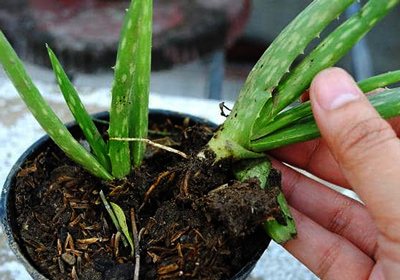

Agave breeds basal shoots and cuttings.
Usually we overgrow with a large number of shoots that already have their own root system.
You just need to take and transplant them.
This is the easiest way to reproduce.
As for the cuttings, then before planting, they are dried for 2-3 days in the air... They are transplanted into sandy soil by 1 cm. For this, ordinary sand or sand mixed with peat is suitable.
Watered very carefully, otherwise the stalk may simply rot. Transplanted into pots 2 weeks after the roots appear.
Reproduction
For breeding agave use shoots, extending from the trunk. They can be placed in water or sand for rooting. This process is pretty quick.
Watering is rare to a state of light sand moisture.
Can be propagated and seeds, which are sown from February to March at a temperature of about 22 degrees.
Read more about breeding aloe here.
Medicinal properties
Both plants have pronounced healing properties, which in some way duplicate each other. However, most adherents of traditional medicine still consider aloe vera to be a more useful plant in a medicinal sense. At the same time, supporters of the agave claim and scientifically prove that this plant contains more useful minerals and natural biostimulants.
Professional pharmacists do not divide these plants into more or less useful, but recognize the outstanding healing qualities of both. Next, we will consider what useful medicinal properties both types of aloe have, and whether there is a difference between these properties.
Agave
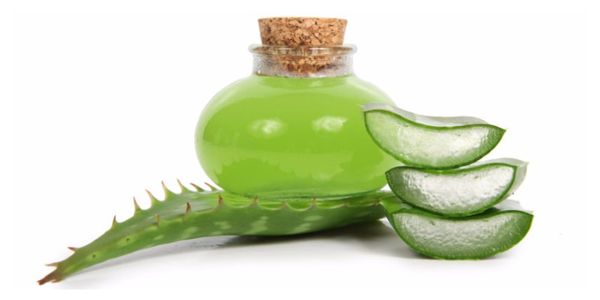

- Lotions with the juice of this plant are able to draw pus from boils and help the latter to heal quickly.
- The juice is also useful after insect bites, it can pacify itching and other unpleasant sensations, and soothe the skin.
- The centenary is very useful in healing cuts, wounds and abrasions.
- The sap of the plant helps to strengthen the hair follicles, can protect to some extent from hair loss. In addition, it helps to get rid of dandruff, makes the scalp healthier and cleaner. With the help of this natural biomaterial, you can also accelerate the growth of hair.
- Agave juice is also used in cosmetology - it improves complexion and helps smooth out fine wrinkles. In addition, the juice perfectly moisturizes.
- The plant is used for varicose veins. Lubricating the affected areas with plant juice, you can relieve leg fatigue, make veins stronger, and eliminate puffiness.
- The agave is also used as a healing agent for ulcers, eczema, as well as psoriasis. It can also be used for other skin diseases.
- The plant has pronounced bactericidal, disinfecting properties. This quality has long been noticed among the people, therefore, agave juice is a popular antimicrobial agent. The sap of the plant will help the fastest healing of burns, tightening of all kinds of wounds of any origin.
If you take the bitter juice of the plant (in diluted form) inside, you can protect yourself from loss of strength, including seasonal. If a man has sexual impotence, the sap of the plant will help to cope with this delicate problem.
In cool weather, the plant can be a real salvation for the whole family from colds, flu and other seasonal misfortunes. The centenarian is famous for its ability to strengthen the immune system.
Important: most doctors and traditional healers agree that agave juice is best used externally.
Aloe vera
For the first time, the use of this plant as a medicine was mentioned in ancient Egyptian papyri. In these historical documents, scientists have found as many as 12 ways to use the plant as a medicine. The juice and gel filler of aloe vera leaves are best used internally - this method is more effective. Further, the healing properties.
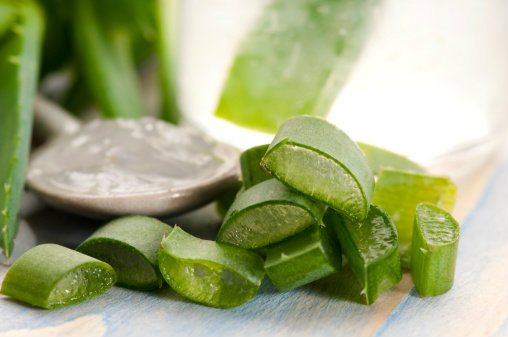

- The juice and pulp of aloe vera help to strengthen the cardiovascular system.
- The juice is also useful for restoring and strengthening the gums. Those who have experienced periodontal disease will certainly appreciate this useful quality.
- Aloe vera is beneficial for revitalizing the urinary tract.
- The juice and pulp of the plant strengthens the immune system, can become real helpers in the winter, relieve colds and other infectious respiratory diseases.
- The plant will also be appreciated by patients with diabetes mellitus. Taken internally, aloe vera juice lowers blood sugar levels in a natural, gentle way.
- The plant protects against heartburn, including during pregnancy, prevents intestinal disorders.
- For patients with arthritis, aloe vera juice is also very useful, as it can calm the pain in this joint disease. In addition, the juice relieves inflammation in the affected area.
- The plant is able to help the healing of microcracks in the skin, activates the renewal of the epidermis, rejuvenation.
Using the sap of the plant, you can saturate the body with essential vitamins and other useful substances. Also, eliminate problems with the stomach and intestines, relieve joint pain, make the blood composition cleaner and healthier, get rid of infections of various natures, help heal wounds and abscesses.
The plant sap has pronounced disinfecting properties, is able to fight most pathogenic bacteria, including:
- streptococci;
- Escherichia coli;
- dysentery bacillus;
- staphylococci.
Using the juice and pulp of aloe vera, you can prepare homemade cosmetics for hair and skin. Also, the plant is used as an effective and mild laxative, choleretic drug.
The plant contains a wide range of valuable vitamins and minerals: A, C, E, almost complete group B, calcium, selenium, potassium, copper, chromium, sodium, magnesium. In addition to the listed components, the composition also contains bioferments, amino acids, anthraglycosides, antioxidants, saccharides, phytoncides and steroid compounds of natural origin that are beneficial to health.
What is the difference between an agave and aloe vera?
Centennial is the "popular" name for Aloe arborescens (Aloe arborescens). Sometimes the whole genus Aloё L. is called agave. Indoor succulents received an unusual name for the fact that they bloom in the temperate zone, as if once in a hundred years. This is not true. It is impossible to achieve flowering in indoor conditions. Long scarlet peduncles are observed annually in tropical or southern Africa.
Aloe vera or real is a herbaceous plant. In ancient times, dwellings were decorated with its shoots. They could hang from houses for years and even bloom without access to water. Also, condensed juice - sabur was obtained from the pulp of the plant. Both plants, like all succulents, are extremely hardy and able to exist where conditions are far from favorable. Can you grow ginger and banana at home?
What is the difference in the structure of aloe and aloe vera:
- the agave has a tree-like erect shoot, and the stem of the second is short, does not form a "trunk". The bulk of the shoot falls on the leaves;
- Habitat is another point that distinguishes aloe from aloe vera.South Africa was developed first, its northern regions second;
- the main morphological difference between aloe vera and aloe is that its leaves, which are thicker and have a different color, are covered with a scattering of white spots. The rosette of leaves is located at the base of the shoot. In the agave, they form a rosette at the top of the stem, die off from below, which causes scars to form. The shape is lanceolate, pointed towards the end, slightly concave. Both species have small spines along the edge.
Both plants give young shoots in the root part, which the plant can reproduce vegetatively.
The annual grows in places with a pronounced seasonality of rainfall and aridity, and is adapted to a lack of water. A bluish tint appears due to a waxy coating that protects against excessive evaporation of moisture.
The chemical composition of Aloe arborescens determines its value as an antioxidant. Phenolic compounds included in its "inner gel" neutralize the effect of free radicals on oxidative processes in cells.
Agave juice contains:
- organic acids;
- amino acids;
- carbohydrates;
- vitamins;
- trace elements.
Among the acids in the gel-like pulp of the leaf, apple predominates. The main amino acid is glutamic; its content in the juice accounts for 0.04%. The main carbohydrates are sucrose and glucose. Phenolic compounds neutralize free radicals, making the agave a promising source of dietary supplements.
Medical use
If you do not have an aloe plant (agave) at home, then you can purchase ready-made, processed plants in solid, liquid or dry form: solution, syrup, juice, tablets and extract.
Such funds are used to treat and prevent the following diseases:
Constipation, gastric ulcer and 12 duodenal ulcer, decreased appetite, gastritis, gastroduodenitis, enterocolitis, cholecystitis; neuralgia, headache; bronchial asthma, tuberculosis, pneumonia; blepharitis, conjunctivitis, keratitis, vitreous opacity, myopic chorioretinitis, iritis, retinitis pigmentosa, inflammatory processes of the eye vessels, optic nerve atrophy, progressive myopia, trachoma; scar tissue changes, trophic ulcers, scleroderma; infertility (including in men); radiation sickness; loss of hearing and smell.
The composition of aloe and agave
It is in this aspect that you can clearly see the relationship between these two plants. We will not delve into a detailed report between the content of substances in each leaf, but the composition of the agave and aloe does not differ from each other.
- Both of these plants are characterized by a unique structure that is saturated with many useful vitamins for the body: they not only store, but also produce a full range of vitamins without interruption. And their properties perfectly complement each other, which in total gives amazing results. This complex consists of vitamins of group B (B1, B2, B6, B9 and B12), C, A and E;
- there was also a place for such mineral components as calcium, sodium, chromium, copper;
- also the composition of aloe and agave includes many amino acids, antioxidants, mono- and polysaccharides;
- it is impossible to mention also the share of bitterness and essential oils in their composition, as well as a large amount of mucus. And it not only contributes to the rapid healing of wounds on the surface of the skin and even mucous membranes, but also acts as an antiseptic.


Due to the large amount of mucus, aloe acts as a strong antiseptic

